
|
Macau Bahá'í Community in the Early Years
by Barbara R. Sims
 |
chapter 5 | start page | single page | chapter 7 |  |
Chapter 6
The first Ridván celebration in Macau was held April 21, 1954. Sixteen people attended, but there were still only three Bahá'ís at that time. Occasionally they had visitors. One of the early visitors was an attractive young American Bahá'í Miss Arden Thur, who came in February 1954. At that time she was staying in Hong Kong temporarily.
On May 1, 1954 Mr. Carl Scherer was appointed a member of the Auxiliary Board of the Hands of the Cause of God in Asia. The jurisdiction was South East Asia. In October 1957 the area of jurisdiction was changed to Japan, Korea and the North Pacific. After his appointment he sometimes traveled to other countries.
The arrival of Mr. and Mrs. Azizi in May that year raised the number of Bahá'ís to five but still there were no Bahá'ís native to the area. In October the Azizis left to reside in Hong Kong. As mentioned previously they tried to get visas to Hainan but could not and were in Macau awaiting visas to Hong Kong. He established a business in Hong Kong so he would qualify for a visa.
In May 1954 the Macau Bahá'ís (still only four) started a Sunday deepening "Worship Hour", which apparently continued for some time.
In 1954 the Macau group was thrilled to receive a letter from the Guardian dated May 11, 1954. It was the only one they were to receive. They noted that it took three months to reach them.
Considering how remote Macau was in those years, the small community had many Bahá'í visitors anxious to help in any way they could. In addition to those mentioned elsewhere in this record the following people should be acknowledged.
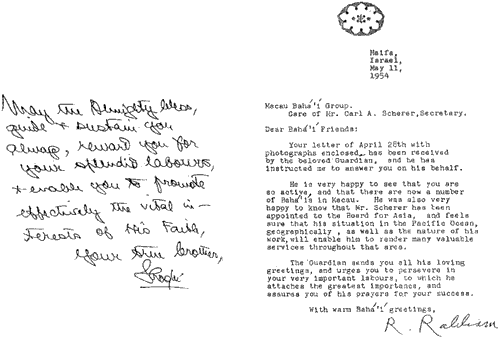 click for larger image |
The Bahá'í community of Macau received one letter from the Guardian, Shoghi Effendi. It took three months to reach them. The original letter is now in the Archives in the Holy Land.
In June 1954 Mr. Charles Murray visited for several days. A devoted Canadian Bahá'í, he was staying in Hong Kong trying to help the Faith. As he could not find employment in Hong Kong he returned to Canada in 1955.
June 14, 1954 Mr. and Mrs. Mottahedeh (Mildred and Rafi) visited Macau. Mrs. Mottahedeh spoke at a meeting to which nineteen people came, thirteen of them non-Bahá'ís. In the eighth year of the Ten Year Crusade (1961) Mrs. Mottahedeh was elected to the International Bahá'í Council in the Holy Land, which the Guardian said was the "forerunner of the supreme administrative institution."
In July Mr. Jamshed Fozdar visited Macau and they had a meeting to which thirteen people came, including seven non-Bahá'ís.
In October 1954 Mr. and Mrs. Seto visited Macau. The Setos (Anthony and Mamie) were early American pioneers to Hong Kong. Mr. Seto was one of the first Bahá'ís of Chinese background. He and his wife accepted the Faith in Hawaii in the fall of 1916. Although Mr. Seto was an American citizen, he was of pure Chinese ancestry. He and his wife chose to pioneer to Hong Kong, arriving October 1, 1954, because he could speak Cantonese Chinese. They were both extremely important in the rise and development of the Faith in Hong Kong. Mrs. Seto had been a member of the National Spiritual Assembly of the Bahá'ís of the United States, and she was a well-known speaker. She was appointed as Auxiliary Board Member in April 1958 by the Hands of the Cause of God in Asia.
Mr. and Mrs. Seto attended the first National Convention of the Bahá'ís of North East Asia in Tokyo in April 1957. A few days after the convention, Mr. Seto was stricken with a heart attack as they were boarding the airplane to return to Hong Kong. He was buried in the Foreigner's Cemetery in Yokohama, Japan. Mrs. Seto went back to Hong Kong alone where she stayed until the end of the Ten Year Crusade.
In 1955 Miss Virginia Breaks, Knight of Bahá'u'lláh, pioneer to the Caroline Islands, visited Macau on her way back from the Nikko Conference in Japan. Also Mrs. Luava Carter visited Macau with Mr. and Mrs. Seto. In 1956 Mr. and Mrs. Charles Bishop included Macau as one of their stops on an extensive trip.

click for larger image
22
Spiritual Assembly of North East Asia
The first National Convention of the Bahá'í of North East Asia was held in Tokyo, April 1957. The North East Asia area was extremely large, encircling Japan, Korea, Formosa (Taiwan), Hong Kong, Macau, Sakhalin Island and Hainan Island. At that time it was not possible to obtain visas for the Soviet territory of Sakhalin, nor for Hainan Island belonging to China. Mr. John Chang journeyed to Hainan in 1959 but left no resident Bahá'í. Hainan was taken out of the territory of the National Spiritual Assembly of North East Asia and assigned elsewhere. Sakhalin remained one of the goals, first, of the National Spiritual Assembly of North East Asia and then of its successor, the National Spiritual Assembly of Japan. It took thirty-three years to fulfill the goal.
In the interests of history, a copy of Shoghi Effendi' s message to that first National Convention of the Bahá'ís of North East Asia is printed here. It was presented to the Convention by the Guardian's representative, Hand of the Cause Mr. Jalal Khazeh.
From outside Japan representatives attended from Taiwan, Korea, and Hong Kong, but unfortunately not from Macau.
With permission from the Guardian Mrs. Heller left Macau on November 4, 1954. She later continued her pioneer services in Mexico. The day she left Macau Mr. and Mrs. Suleiman A. Suleimani visited for one day. This couple had spent many years in Shanghai, where her father, Mr. Uskuli, had a business. He remained in Shanghai until his death in 1956 and is buried in the Shanghai Kiangwan cemetery. The Suleimanis were on their way to Taiwan, the first Bahá'ís to pioneer there. This devoted couple remained at their post in Taiwan until they died, she in 1981 and he in 1987.
On January 16, 1955 the Bahá'ís held a World Religion Day meeting, with Mr. Scherer speaking. Nine non-Bahá'ís and four Bahá'ís attended.
In March 1955 the community was happy to receive a letter from the Hands of the Cause residing in the Holy Land, signed by Mr. Leroy loas. It was in answer to their Naw-Rúz greeting.
The group printed an introductory pamphlet in Chinese that year. Both the National Spiritual Assembly of the United States and its Asia Teaching Committee wrote them glowing letters of appreciation for their endeavors, the latter writing, "As the first Bahá'í group to be formed in the areas assigned to this committee under the World Crusade, we are very proud of you."

click for larger image
The First Prayer Book in Chinese
There had been translations of Bahá'í literature into Chinese in the 1930s and 1940s by Prof. T.S. Tsao and Mr. Chan S. Liu in mainland China. However, this was the first prayer book to be translated into Chinese. It was done by Mr. John Chang and printed in 1956. Shown here is the title page and first page. The outside cover is dark green. Mr. Chang thought there should be some prayers for the growing Macau community. He selected 22 suitable ones from an American prayer book. Several years later he added more prayers and another prayer book was printed in Chinese by the Chinese Translation Committee in Taipei, Taiwan in 1961.
On May 22, 1955 with the declaration of Mr. John Chang the group membership reached nine. However, at the time, Local Spiritual Assemblies could only be formed at Ridván so the group did not qualify.
In 1955 the Macau group was invited to send a representative to the Asian Teaching Conference, held in Nikko, Japan. It was the first Bahá'í conference in Asia, and great importance was attached to it. Hand of the Cause Mr. Zikru'llah Khadem was the Guardian's representative. Miss Charlotte Linfoot, a member of the National Spiritual Assembly of the United States was assigned to represent that assembly, which was the sponsor of the conference. The Tokyo Local Spiritual Assembly made all arrangements as there was still no National Spiritual Assembly in North East Asia.
Representatives came from Guam, Taiwan, Korea, Iran, Caroline Islands, Hong Kong and Macau. There were about sixty adults and several children of pioneers. Mr. and Mrs. Scherer and Mr. Harry Yim attended from Macau. Mr. Yim with his warm personality made many friends in Japan, and he could also get a broader vision of the Faith.

click for larger image
Mr. Philip Marangella, who lived in Japan but was an inveterate traveller and spreader of the Teachings, visited Macau in 1957. He is shown here on the left. Mr. and Mrs. Chang are in the middle with Mr. Yim on the right.
In 1956 there was an important "first". Mr. John Chang translated 22 prayers from the American prayer book into Chinese. That small blue prayer book, printed in Macau in 1956, was the first prayer book in Chinese, although other books had been translated into Chinese some years earlier by T.S. Tsao and Chan S. Liu. Mr. Liu had some of his translations printed in Macau on a personal basis long before a community existed there.
Some years later, in 1961, the small prayer book was expanded and printed in Taipei, Taiwan, by the Chinese Translation Committee of the National Spiritual Assembly of the Bahá'ís of North East Asia. That printing was done in collaboration with Mr. Chang.
On April 19, 1957 the resident Bahá'í pioneer, Mr. Scherer, had an interview with the governor of Macau, Mr. Pedro Correia de Barros. The governor mentioned that he had heard of the Faith in Mozambique, Africa, which at that time was under Portuguese rule.

click for larger image
Mr. William Smits, pioneer to Korea, Mr. William Jasai, a Portuguese soldier and Mr. Nari Sherwani, who as a youth was among the first to accept the Faith in Hong Kong. This photo was taken in Macau in 1957. Mr. Jasai was studying the Faith and became a Bahá'í the following April. He was a member of the first Local Spiritual Assembly of the Bahá'ís of Macau, 1958. He left shortly after to return to his home in Africa.
The Macau community consisted of nine Bahá'ís in April 1957 but Mr. Paul Kao felt he had to resign from the Faith which he did on April 20 as he had accepted a position in a Catholic school. To the disappointment of the other eight believers they could not form a Local Spiritual Assembly, which had been their goal.
The late 1950s saw more visitors to Macau: Mr. William Smits, who was pioneering to Korea visited Macau three times. One time he stayed over two weeks. The Macau secretary wrote to the mother assembly that Mr. Smits was a great gain for the Bahá'ís as he never tired of talking about the Faith. Miss Lecile Webster, who was traveling with Mrs. Thompson came through Macau. Mrs. Jeanne Frankel and her mother Mrs. Margaret Bates came in 1958 as did Mr. William Maxwell, pioneer to Korea. Mr. Maxwell was chairman of the National Spiritual Assembly of the Bahá'ís of North East Asia. A meeting was arranged and he spoke on World Brotherhood to the 16 people who came, nine guests and seven Bahá'ís.
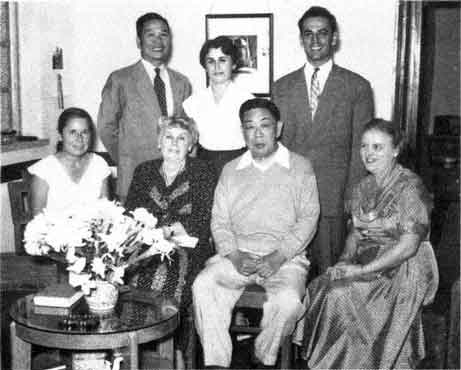
click for larger image
Mr. and Mrs. Anthony Seto (middle), early pioneers to Hong Kong visited the Macau group October 1954. Mrs. Heller is sitting to the left; Mrs. Scherer to the right. Standing are Mr. Yim, Mrs. Azizi and Mr. Azizi.
Mrs. Edith Danielsen-Craig, pioneer to Taiwan, Mr. Yadollah Rafaat, pioneer to Japan and Mr. and Mrs. Noureddin Mumtazi visited at different times in 1959. Mr. Rouhollah Mumtazi (appointed as Counsellor in 1968) visited the Bahá'ís of Macau several times. The Mumtazis were pioneers to Japan. In 1960 the well-known Bahá'í teacher Mr. Mohammad Labib, visited Macau and went on a teaching trip to Taipa and Coloane. Mr. Jack Davis, pioneer to the Philippines visited in 1960. Of course, the Hong Kong Bahá'ís often went to Macau to help with the teaching; Mr. Azizi, Mr. and Mrs. Datwani and Mr. Nari Sherwani. Mr. and Mrs. Datwani accompanied pioneer to Japan Mrs. Joy Earl, to Macau in 1956.
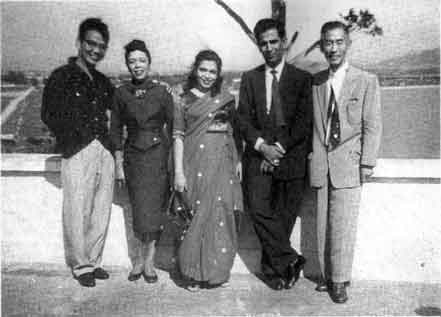
click for larger image
Mrs. Joy Earl, pioneer to Japan, second from the left, was taken for a visit to Macau by Mr. and Mrs. Datwani of Hong Kong, second and third from the right, October 17 and 18, 1956. They attended the regular Sunday fireside. Mr. Chang is on the right and Mr. Yim is on the left.

click for larger image
This was the program for the first public meeting in Macau. It was mimeographed on pale blue paper. Although there were difficulties finding a place to hold the meeting attendance was the best ever, a total of twenty-two people including fifteen seekers.
On December 8, 1957 the community held their first public meeting. According to an account written by Mr. Scherer, they had difficulties from the beginning. They reserved a room in a local high school. But the Presbyterian Church brought pressure to bear and permission was canceled. Then a primary school gave them permission to use one of the rooms. Another Protestant church applied pressure on the principal so that the primary school would withdraw permission. However, due to the intervention of Mr. Chang, permission was once more granted. The advertisement in the newspaper had to be altered suddenly but the meeting resulted in the largest non-Bahá'í audience ever; fifteen people. There was a total of twenty-two people including the Bahá'ís. Mr. and Mrs. Datwani and Mr. Sherwani came from Hong Kong to attend this first public meeting. Those three Bahá'ís held Indian passports. Some time after that Macau was closed to possessors of Indian passports and the three were unable to make more trips to Macau for a time.
Thirty paid advertisements were inserted in the newspapers that year, including the one advertising their first public meeting.
Teaching work was started in Coloane and Taipa, but there were no enrollments until several years later, in 1972.
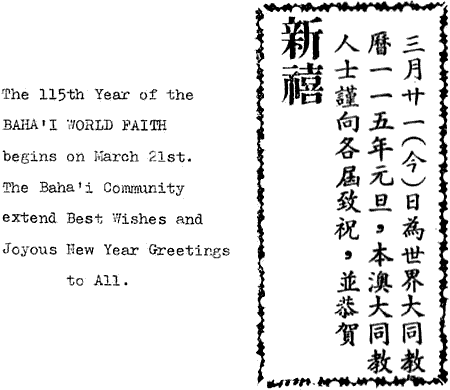
A Naw-Rúz greeting printed in the newspaper March 21, 1958
During 1957 the community was quite active. There were ten general meetings, they observed all Feasts, had several special meetings for guests, but there were no enrollments.
Mr. Scherer wrote, "The Chinese are unwilling to commit themselves to a new religious system for fear of political repercussions. Rumors about the eventual return of Macau to the mainland are affecting people's lives."
In 1958 there were enough enrollments so that they could elect the first Local Spiritual Assembly on April 21, 1958 and although the pioneers and foreign Bahá'ís later left, the assembly functioned for several years, until 1966. Then it was not re-elected until 1969.
Members of the first Local Spiritual Assembly of the Bahá'ís of Macau were Mr. Yim, Mr. and Mrs. Scherer, Mr. Canhita, Mr. Ferreira, Mr. John Chang, Mr. William Yang, Sgt. Julio Mata and Cpl. William Jasai. Later in the year Mr. Yuen was elected to fill a vacancy as Mr. Jasai and Mr. Ferreira left that year.

click for larger image
The first Local Spiritual Assembly of the Bahá'ís of Macau, formed April 21, 1958. Front: Mr. Harry Yim, Mrs. Loretta Scherer (treasurer) and Mr. Joaquim Canhita.
Rear: Mr. Carl Scherer (secretary), Mr. Manuel Ferreira, Mr. John Chang (chairman) and Mr. William Yang (vice-chairman).
Absent members: Mr. Julio Mata and Mr. William Jasai. Their photographs can be found elsewhere in this book; Mr. Mata in the 1959 Naw-Rúz photo and Mr. Jasai in the 1957 photo with Mr. Smits and Mr. Sherwani.
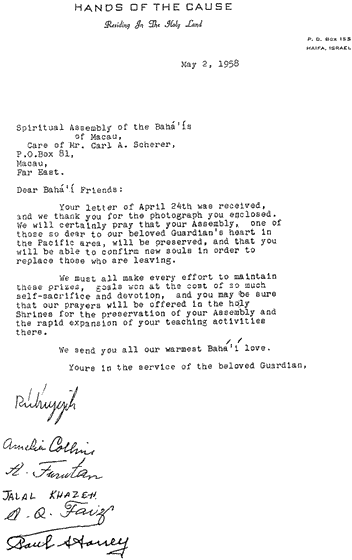
click for larger image
In the period of time between the passing of the Guardian, Shoghi Effendi, in November 1957 and the election of the Universal House of Justice in 1963, the affairs of the Faith were guided by the Hands of the Cause of God residing in the Holy Land. Letters such as the above were a great encouragement, not only to the small group in Macau, but to Bahá'ís everywhere.
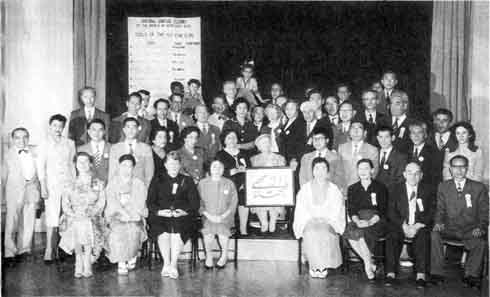
click for larger image
This is a photo of the Third Convention of the Bahá'ís of North East Asia, held in Tokyo 1959. Macau had formed its first local spiritual assembly the year before and thus became eligible to send a delegate to the convention. It was no surprise when Mr. Yim was elected as delegate. He is shown a little left of the center, second row from the back, wearing glasses and a bow-tie. Hand of the Cause Miss Agnes Alexander is shown holding the frame containing the "Greatest Name".

click for larger image
The Macau group sent out a very attractive greeting card in 1959. The dark parts, except for the lower center, are actually bright red.
That first assembly, typical of many Bahá'í assemblies throughout the world, was an assortment of races: Chinese, Americans, and Portuguese. Mr. Jasai, a new Bahá'í, was a black Portuguese from Africa.
By March 1959 there were ten Bahá'ís in Macau and the Scherers had left permanently to return to the United States. Later they pioneered to Portugal and in 1973 returned to Macau for about three months. Mr. Scherer is listed as being a member of the 1973 Local Spiritual Assembly.
Members of the second Local Spiritual Assembly, elected 1959, were Mr. Yim, Mr. Chang, Mr. Mata, Mr. Joaquim Canhita, Mr. Peter Chou, Mr. Domingo Vilas, Mr. Wu Tze-Ming, Mr. William Yang and Mr. Jimmie Yuen.
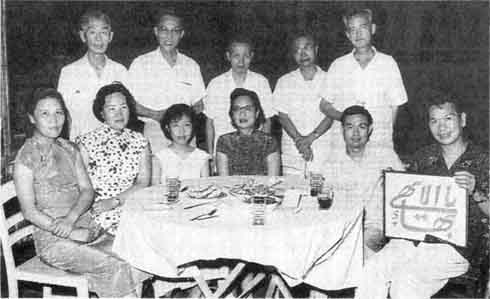
click for larger image
This was a moonlight meeting held on September 17, 1959 on the roof top of Mr. Chang' s residence. It was on the occasion of the Chinese Mid-Autumn Festival and was sponsored by the Local Spiritual Assembly. Seated: Mrs. Chang, Mrs. Liu, Miss Pan, Mrs. Pan, Mr. Jimmie Yuen and Mr. Yim. Standing: Mr. Chang, Dr. Liu, Mr. T.M. Wu, Mr. Yip and Mr. C. Short.
The Portuguese Bahá'ís, all of whom were in the Portuguese Army, were not permanent. Mr. Manuel Catario Ferreira left for Portugal October 1958 and Mr. William Jasai left for Africa April 28, 1958. All of the Portuguese Bahá'ís had gone by 1960. Mr. Jimmie Yuen left for Hong Kong in December 1960. These were great losses for the small community. Mr. Azizi came almost every week from Hong Kong to help with the teaching. At that time the secretary of the community Mr. Yim, wrote to the National Spiritual Assembly in Tokyo, "In what way can we attract the hearts of the people?"
 |
chapter 5 | start page | single page | chapter 7 |  |
|
|